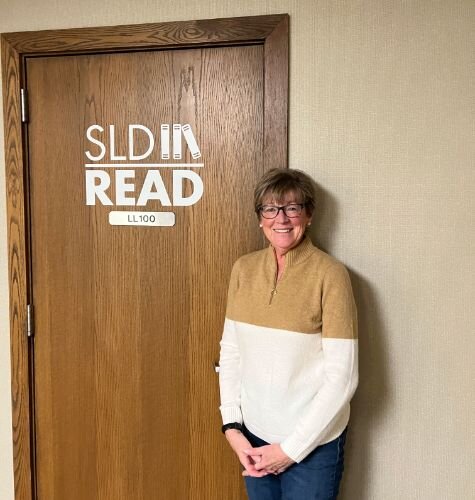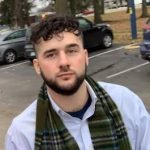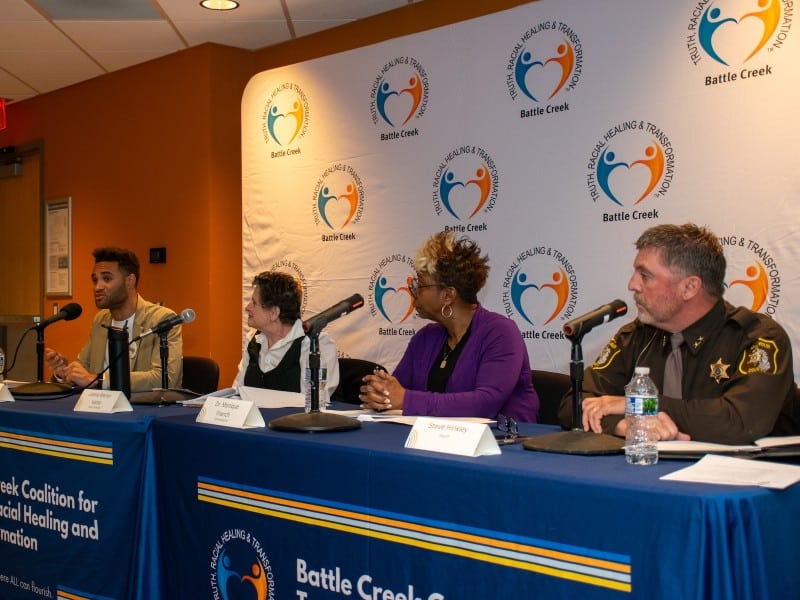“Literacy is a crisis for our youngest scholars,” says Kristen Potts, CEO of SLD Read, formerly Specific Language Disability Learning Center. SLD Read states its mission is “to support individuals with learning disabilities, including dyslexia, in achieving lifelong language skills through our multi-sensory tutoring program; assist educators in supporting students with learning disabilities; and help increase community awareness and understanding of literacy issues.”
The word “crisis” may seem a bit strong, but once Potts discussed the reading proficiency level of Michigan’s fourth-grade students, it fit the situation and justifies the organization’s need for tutors.
Only 35% of Michigan’s fourth graders are reading proficiently at their level, according to the 2019 National Assessment for Educational Progress. This leaves Michigan in the dust compared to almost forty other states in the nation. Second Wave Media had the opportunity to sit down with Potts at the SLD Read office in Kalamazoo, Michigan to discuss the current plight.
Why is fourth grade so important?
Potts spoke definitively about how once children approach the fourth grade, the teaching method transitions from learning to read to reading to learn. Fourth grade is when students are expected to read on their own – at school and home. In the classroom, the teacher is there to guide and answer questions but is very rarely giving the lesson orally to the students. Up until fourth grade, oral lessons are very common. “That is a big switchover,” remarked Susan Schwallie, SLD Read board member, and parent of a youth who receives tutoring.

Nowadays, it is no secret that teachers are expected to do more with less, especially since the COVID-19 pandemic. Without adequate resources, the schools typically focus on students who are falling behind in an array of subjects, not just reading and/or writing. Students who have dyslexia may go undiagnosed until they are expected to read at home when their parents notice. One-on-one tutoring with strategies specific to the student helps them catch up while also building confidence.
A common thread that educators mention is that young students know they are falling behind, either through their realization, or because other students and even teachers have told them. Once Schwallie realized that her son, who was in second grade at the time, was reading at a kindergarten level, she reached out to a friend in her area who recommended Dr. Michael Ryan. The doctor, who specializes in treating dyslexia, ADD, and other learning disabilities, helped diagnose Schwallie’s son and point her in the direction of SLD Read.
SLD Read uses a multi-sensory style of reading and writing instruction called the Orton-Gillingham method. Created by the neuropsychiatrist and pathologist Dr. Samuel T. Orton and the educator and psychologist Anna Gillingham in the 1930s, this way of teaching allows students to learn the science of reading through various senses. At the SLD Read office, Potts showed off just a few of the many resources available for students and tutors to use during their meetings. Potts demonstrated a gel pad where letters could be written out and erased, a tube held between the mouth and ear that helped amplify word sounds, and even a mini bowling set that is used to help learn and memorize spelling rules.

According to Potts, reading is difficult for many. Potts expressed that although some people may take to reading very naturally, it does not mean that it is an easy process for the human brain to complete. During an outreach event in November 2022 at SLD Read, attendees were taught about the part of the human brain that is dedicated to speech. There is no such part dedicated to reading or writing.
In most human brains, the synapses fire in just the right way that makes reading and writing possible. For people who have a learning disability, such as dyslexia, these same synapses do not always fire in this order, which means that reading and writing can become incredibly difficult. Difficult, but not impossible. Potts is very firm in her belief that although reading may be difficult, “The science of reading is made for every person.”
One important part of SLD tutorship is that the tutors help students create strategies that assist them to learn and retain phonics rules. SLD Read tutor Linda Johnson joined the organization in 2016 as a tutor, after “literally pacing around the house” out of boredom during retirement. Johnson started in special needs education and worked at the JFK Center School (closed in 2021) for 14 years. She continued to teach at Kalamazoo Northside’s Lincoln Elementary, and then transferred to Northglade Elementary School. After teaching there for five years, Johnson left and became a literacy coach under the Reading First grant. It is evident Johnson cares deeply about a child’s ability to read, and to help new readers gain access to the resources that come along with that skill.

Johnson says, “Anyone who tells you reading is easy doesn’t get it. Reading is hard.” She told Second Wave that being a tutor was even better than she expected because the children touch your heart.
The young students have been told they aren’t as good as the others around them, and they are looking for a way to belong.
“We believe in them at SLD,” says Johnson.
Potts would like for students to feel like school is “their place,” and that it “belongs to them.” When young students are not reading at grade level, their confidence is shot, and it is unmistakable that the classroom has become a source of anxiety. This was echoed by every single interviewee, including the parent of an SLD student with dyslexia and a nonverbal learning disorder, Jennifer Brower.
Brower has sought out SLD Read tutoring for two of her three children. Brower was prompt in noting that both she and her husband have careers in the medical field, and realized early when their oldest daughter showed signs of dyslexia. Brower says that with their son, she and her husband did not notice that his reading and writing were suffering until he and all his classmates were sent home at the start of COVID-19.
“We didn’t want to try to explain to someone what it was (dyslexia),” remarked Brower, and luckily they did not have to. “The training that SLD offers for new tutors is very thorough, and the support you get throughout is wonderful,” says Johnson. Tutors are supplied with all of the tools they will need to be successful within the Orton-Gillingham Method, and the longer someone tutors, the more their personal style of teaching has time to develop. Each student is different, and comes with a different “struggle,” as one of Johnson’s pupils calls it.
“We have resources, and that is the reason my kids are able to get the help,” says Brower. The financial aspect is one of the largest roadblocks to a young student receiving the literacy help they need. Schwallie says that only once she was able to provide test results from an outside source would her son’s school psychologist assess him for a possible learning disability. Many parents and families do not have the resources to take the route of Brower or Schwallie.

SLD Read is searching for more tutors to bolster its reach in the community. At the start of the COVID-19 pandemic, Potts says, SLD lost about 50% percent of their tutors. This lack of tutors severely cut the number of students SLD was able to help. Potts says that SLD needs tutors who do it not only for employment but for enjoyment. During our interview, Potts noted that time is more valuable than ever and that SLD Read understands this.
Brower and Schwallie provide insights into how difficult it can be to find the help your child needs, without faulting the educators at their children’s schools. The capability to provide specialized literacy education to all students with learning disabilities is not available. SLD Read wants to fix this by bringing on more tutors to serve more students, and by continuing its partnership with several area schools and universities, including a partnership that brings the SLD Read training right into the schools to make it easier for the parents and tutors to collaborate. This in-school training is also for educators and creates a more robust knowledge base on which those teachers can rely.
“Working with kids, you get more back than you give them. Whether it’s something that can be evaluated (success in reading), or just emotionally,” says Johnson. The time she spends tutoring, she says, is “a feel-good hour.”

You do not have to be an educator to be a tutor.
This sentiment was repeated by both Potts and Johnson. The most important part is a passion for helping our youngest learn how to read and write, giving them the skills they need for opportunities that only come with literacy. “Not being able to read proficiently can lead to a lot of struggles in life, such as loss of self-esteem, failure to complete school, difficulty finding work, and even prison,” says Schwallie. Brower wanted to end her interview with a message of hope for all the parents out there who are confused about how to seek help, and are worried about their child, telling Second Wave,
“They will come out on the other side.”
Brower’s daughter is now in 11th grade and looking at colleges. Her son is in 8th grade, and as she calls it, is one of the most popular people she knows, wearing his dyslexia diagnosis like a badge of honor. Schwallie’s 11-year-old son is more confident than ever, and in her words is “firing on all cylinders at school.” The students respond to the one-on-one tutoring that SLD Read provides, and there is a need now more than ever for members of the community to step in and help the youngest of us succeed, one word at a time.
SLD Read connected with families in eighteen counties last year, with its focus areas being Battle Creek, Kalamazoo, Grand Rapids, and Big Rapids. Tutoring is available online and in person. The next tutor training is on February 6th. If you would like to learn more about becoming a tutor, please click this link.














